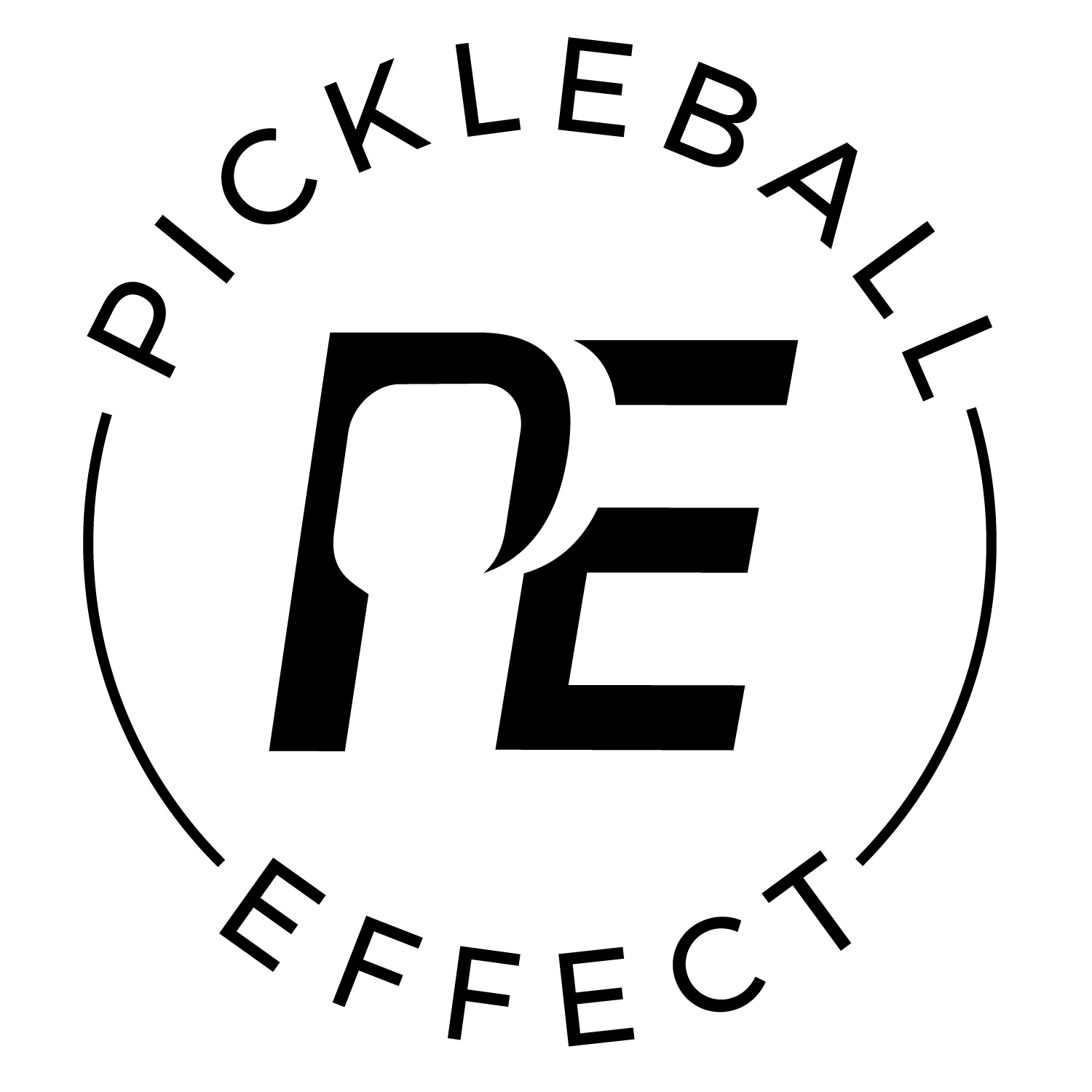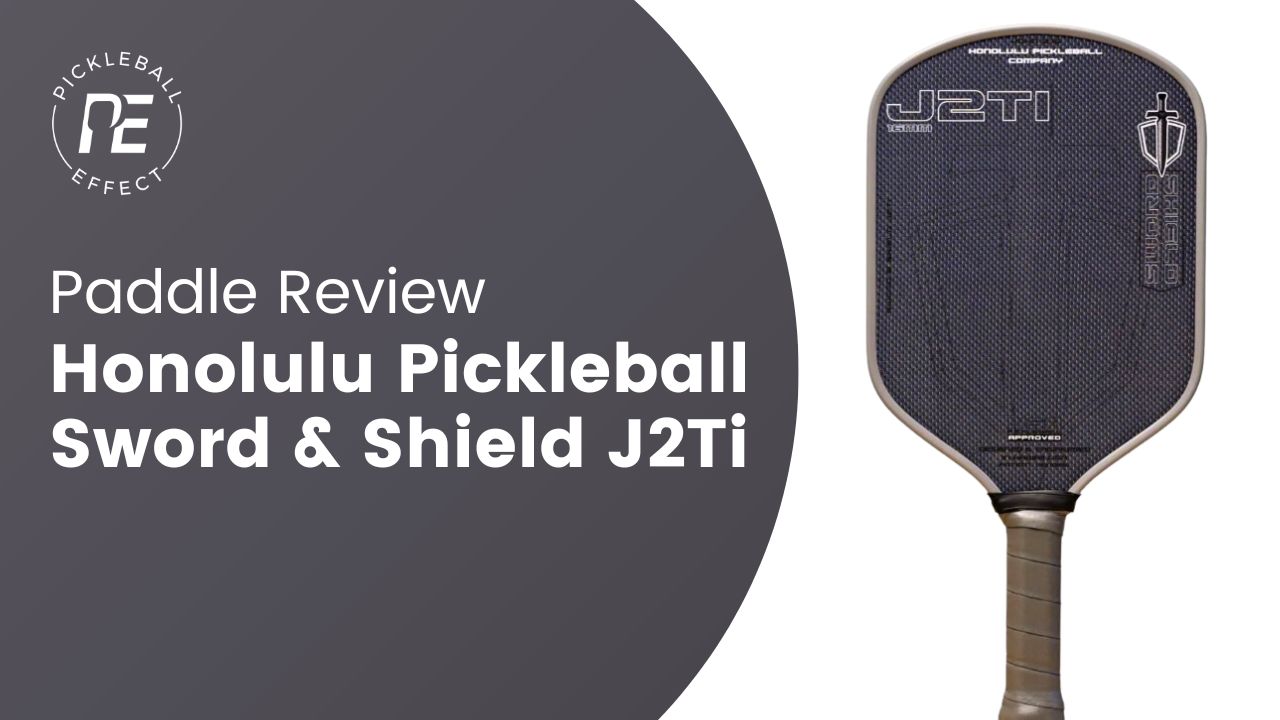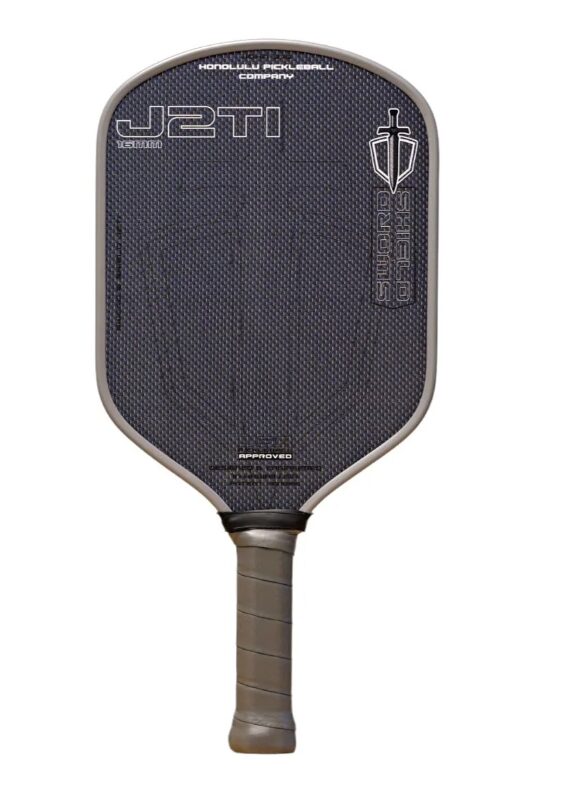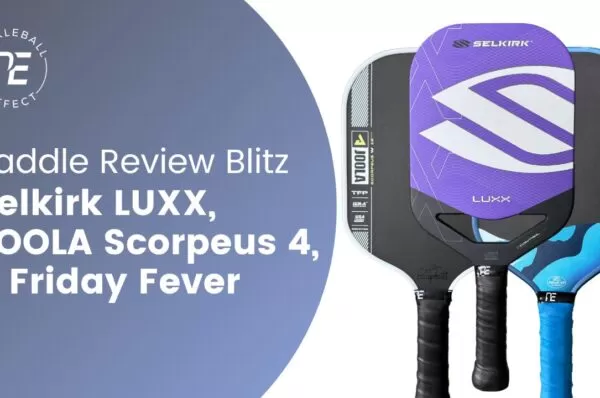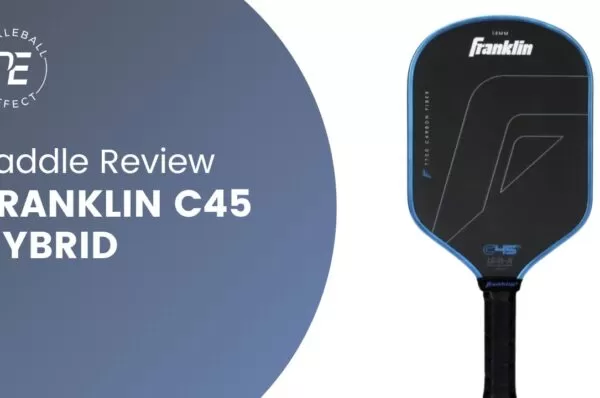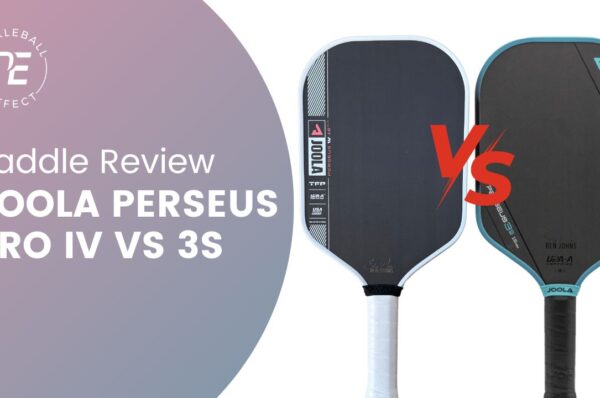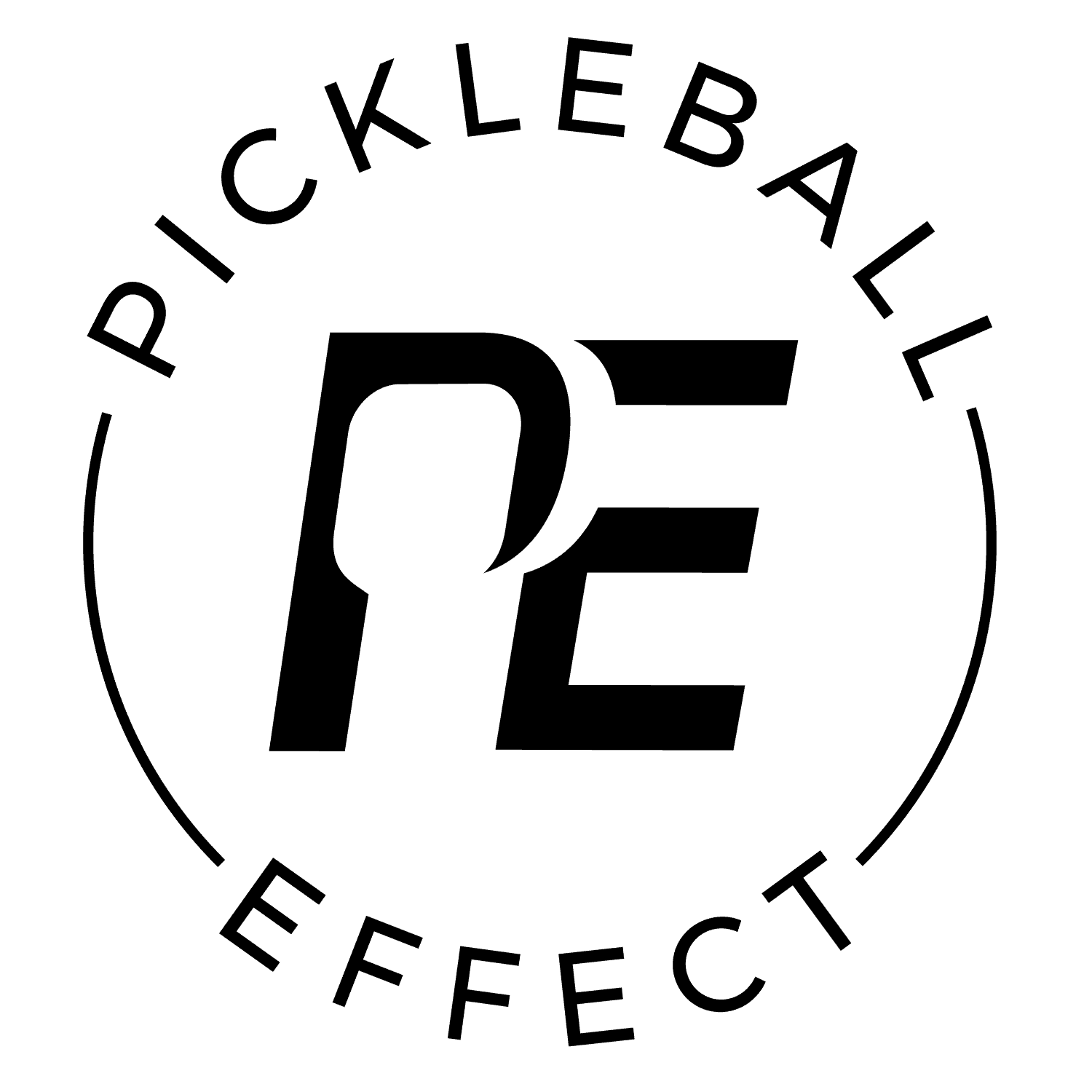Honolulu Pickleball hit a home run with their J2K paddle. I did a review earlier this year of that paddle you can check out here. The short and sweet is that the paddle is the most forgiving hybrid shaped paddle I’ve played and falls nicely into the all-court category. There are many fans of the paddle but those that didn’t like it often cited that it has a stiffer feel that doesn’t jive well with them. In response, Honolulu made the J2Ti. Everything is the same about the J2Ti except that the top facing layer has a polyester/carbon fiber weave face instead of the kevlar face of the J2K. This small change softened up the feel of the paddle but it also changed a couple of other characteristics that I’ll discuss in this review.
After playing and drilling with the J2Ti, and comparing it side by side with the J2K, here’s my review of its performance.
Table of Contents
Performance Summary
Sword & Shield J2Ti
- Static Weight: 8.0-8.4
- Swingweight: 113-115 (moderate)
- Twistweight: 6.9-7.1 (high)
- Spin RPMs: 1958 (high)
- Length x Width: 16.2″ x 7.8″ (hybrid)
- Face: Polyester/carbon weave
- Grip Circumference: 4.125″
- Handle Length: 5.5″
- Core: 16mm Polypropylene Honeycomb, Foam Walls
- Special Features: Thermoformed
- Paddle Type: All-court
- Price: $155 ($140 with code PBEFFECT)
- Warranty: 6 months
(Get 10% off with the discount code PBEFFECT directly on their website)
Like the J2K, the J2Ti falls into the all-court category, but with a more control-oriented focus.
The J2Ti distinguishes itself with a softer feel at impact and reduced pop compared to the J2K. This softer touch enhances control but diminishes some offensive potential. While baseline power and serve drives remain comparable to the J2K, counters don’t have as big a punch, and roll volleys require a slightly more aggressive swing for optimal pace.
Despite a higher static weight, the J2Ti boasts a lower swingweight. This unique combination contributes significantly to its impressive forgiveness. The added weight provides stability and dampens vibrations, while the low swingweight ensures easy maneuverability and effortless handling.
Spin performance is excellent. The paddle exhibits high spin rates out of the box and possesses a notably rough surface texture, a characteristic uncommon in most polyester/carbon fiber weave paddles.
My Recommendation
Honolulu’s J2 design is the most forgiving hybrid shaped paddle you’ll find which is what makes it so unique and popular. I thought Honolulu was smart to create their best selling paddle with the polyester face. It softened up the paddle nice without changing too many things about what made the original J2K so great. It gives people two options to pick from to suit their needs. Go with the J2K if you’re okay with a stiffer feel and want an aggressive style hybrid paddle. Go with the J2Ti if you’re a sucker for softer feeling paddles, still want an all-court style paddle and are okay with giving up some pop in favor of more control.
Plus, the paddle priced well at $140 after code. It’s always nice to find a good paddle that plays well and competes with $200+ paddles at a better price.
Last thing to note here is that Honolulu Pickleball is an openly Christian company and has the bible verse John 3:16 printed on the top of the face of each of their paddles.
(Get 10% off with the discount code PBEFFECT directly on their website.
Braydon competes at the 5.0 level and plays in 5-10 tournaments a year. He plays/drills 3 to 4 times a week and would play more if time allowed it.

Paddle Terms Glossary
We’ve categorized paddles into three categories. Control, All-Court, and Power. Paddle categories are determined by Braydon after he hits or reviews the paddle.
- Control paddles offer a softer feel and better absorbs pace off the ball but doesn’t give you as much power.
- All-Court paddles give you a blend of power and control and does well at everything though it doesn’t excel at anything.
- Power paddles often have a firmer feel and will return more power but are harder to control.
A paddle’s weight represents the inherent mass of the paddle as measured on a scale. However, relying solely on this static weight measurement can be misleading when assessing the true perceived heaviness of the paddle. Even if two paddles both clock in at 8 oz, their actual heft in your hand can markedly differ due to variations in weight distribution within the paddle. This is why the static weight should be considered with the swingweight of the paddle. See the definition of swingweight below.
The weight value listed in the database corresponds to the paddle’s weight that I used to gather the swingweight and twistweight measurement. It’s possible that if your paddle has a different static weight than then the swingweight and twistweight may be slightly different.
There are three primary shapes a paddle can have which consists of the length and width of the paddle. These three shapes are:
- Elongated: The dimensions for an elongated paddle are 16.5″ x 7.5″.
- Standard: A standard shaped paddle has dimensions of 16″ x 8″.
- Hybrid: A hybrid shaped paddle falls somewhere in between the standard and elongated shapes, with approximate dimensions of 16.25″ x 7.5″-7.7″.
Then there are two less common shapes you’ll see. These are:
- Extra-Elongated: This shape is 17″ x 7″
- Widebody: This any paddle shorter than 16″ long.
When considering the advantages and trade-offs of paddle shapes, it’s important to understand the characteristics of each shape.
- Elongated Paddle: An elongated paddle offers increased reach, spin, and power. However, this additional reach comes at the expense of forgiveness, particularly from side-to-side.
- Standard Paddle: In contrast, a standard-shaped paddle provides less reach and a little less power & spin but offers greater overall forgiveness. This means that while you may not have the same extended reach as an elongated paddle, you gain better control and stability.
- Hybrid Paddle: The hybrid shape serves as a middle ground between the elongated and standard shapes. It provides a balance between reach and forgiveness, offering players a versatile option that combines aspects of both shapes.
It’s interesting to note that advanced players often prefer elongated shapes. On the other hand, players at lower skill levels typically opt for the extra forgiveness offered by standard shaped paddles.
Ultimately, the choice of paddle shape depends on an individual’s playing style, preferences, and skill level. Whether your focus is on reach or forgiveness, understanding the unique benefits and trade-offs of each shape can assist you in selecting the paddle that best suits your game.
Swingweight is a measure of the paddle’s resistance to swinging about the end of the handle. The higher the swingweight number the heavier it will feel in your hands. A higher swingweight has more power but is harder to swing, lower swingweight is easier to swing but has less power. Sometimes a faster swing with a lower swingweight can make up for power lost in swingweight. The price paid for that is greater impact shock. Stock swingweights will vary between 100 – 140.
Twistweight is the resistance to rotating around the long axis through the middle of the paddle from butt to tip. The higher the twistweight the more resistance the paddle has to rotating on off center hits. This measurement is closely related to the amount of forgiveness or the size of the sweet spot of the paddle. A higher twistweight indicates a bigger sweet spot. Twistweight numbers range from 5 – 8.
Measuring the revolutions per minute (RPMs) off of a serve you get a number that shows the spin potential of a paddle. Using these RPM measurements I’ve created five buckets that a paddle will fall into indicating its overall spin potential. The five buckets are:
1900 or Higher = Very High
1700 – 1900 = High
1500 – 1700 = Medium
1300 – 1500 = Low
1300 or less = Very Low
You can tell a big difference in the amount of spin a paddle generates when you compare a Very High paddle to a low paddle. But the gains from Medium to High to Very High are marginal. We’ve found that having at least a medium rating is often enough if you’re looking for a good spin paddle. However, if you’re a big hitter then you will benefit more from a high spin paddle to help you keep the ball in play more often.
The power level of a paddle is shown in miles per hour (MPH) after taking ten measurements with a speed gun of hitting a serve as hard as I can. This measurement gives you an idea of how hard you can hit the ball when given the chance to take a full swing. So shots like serves, drives and overheads. The higher the MPH reading the more power you can generate with the paddle.
I also show the percentile ranking of the measurement to give you an idea of how it stacks up against the rest of the paddles in my database.
The pop level of a paddle is shown in miles per hour (MPH) after taking the average of ten speed gun measurements of hitting a punch volley as hard as I can. This measurement gives you an idea of how hard you can hit the ball on shorter swings and gives you an idea of how quickly a ball comes off the face when you apply less force on the ball. So shots volleys, dinks, counters, and resets are all affected by the pop measurement. The higher the pop measurement the stronger your counters will be but it takes more skill to keep the ball from floating or popping up on you when resetting a hard hit ball or when dinking.
I also show the percentile ranking of the measurement to give you an idea of how it stacks up against the rest of the paddles in my database.
